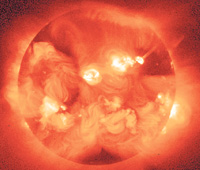Next time you look up at the night sky, take a moment to try and count the number of stars you can see with your naked eye. You'll find that it's almost impossible. (Of course, it'll have to be on a clear night with no clouds in the sky).
The part of the sky that we can see on a daily basis contains around 3000
visible stars. That's quite a lot, isn't it? But in an
astronomical scale, this is a very, very small number indeed, because our
universe is a very big place. Let us try and understand just how big it really is.
 |
| The Sun |
The closest star to our home planet the Earth is, as you know, the Sun. It is a huge ball of gas that
consists mainly of hydrogen and helium, located a
staggering 150 million
kilometres from where you are right now.
If you were to take an aeroplane to the Sun from Earth, it would take nearly 20 years to get there. Running would get you there in a thousand years while a snail would take 4.7 million years to reach it.
It is so gigantic that you could easily fit one million Earths inside it.
It's amazing just how big and inaccessible the Sun is, isn't it? And yet it appears so close and so small in the sky. You think that's bad? Wait till you hear about our second closest star – Proxima Centauri.
Before we go there, let's talk about light,
something most of us take for granted. Light comes from the Sun, from electric bulbs and various other sources. It is made of particles known as photons.
These photons travel extremely fast. So fast that, according to world famous Physicist Albert Einstein, it is the
maximum speed any object could ever hope to reach – an unbelievable 300,000
kilometres per second.
He famously theorised that nothing ever has, or ever will reach that
incredible speed – ever. Now, let's go back to our Sun for a bit. It is true that it's really far away from Earth. But believe it or not, light coming from the Sun only takes eight
minutes to reach us. Compare that to the
20 years a jet plane would take.
 |
| Part of the Milky Way seen from Earth. |
The reason we had to deviate from the topic is this: the universe is just too big a place to be
measured in kilometres. We need a much bigger measurement. Light, being the fastest thing in the universe, is a good
candidate.
A beam of light travelling at 300,000 km/s will travel 1,080,000,000 km (over 1 billion) in an hour. Multiply that by the
number of hours in a day (24) and then by the
number of days in a year (365) and the result you get is truly impossible to even imagine – a whopping
10 trillion kilometres
(approximately).
This is what is known as a 'light year', the distance a single beam of light will travel in a year. And guess how far Proxima Centauri is? It's located 4.2 light years away from Earth. And we thought the Sun was too far away.
This means that when you look up at the night sky and see Proxima Centauri, you're actually seeing what it was 4.2 years ago.
If something were to happen to it right now, astronomers here on Earth would take another 4.2 years to notice.
And you can forget about travelling there in a hurry. The famous Voyager 1
spacecraft that is now passing the borders of our Solar System travelling at 17 km/s (which is quite an
incredible speed if you think about it) will take 76,000 years to reach it. Makes you feel slow,
doesn't it?
There's much more to be said about the sheer
vastness of space of course. Next time, we shall explore our galaxy, the Milky Way. Till then, try to locate the constellation Orion in the sky. It shouldn't be too
difficult. |



